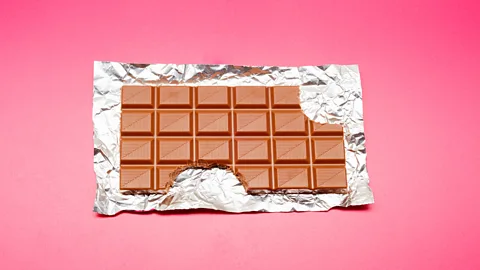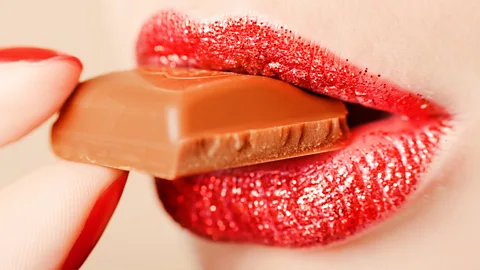Why British chocolate tastes the way it does
 Getty Images
Getty ImagesFor some, there is nothing that beats the sweet, creamy, slightly baked flavour of British chocolate, while others find it an affront to their tastebuds. But why does it taste that way at all?
Imagine a taste test with identical-looking squares of milk chocolate, each from a different country. If you tasted them like a sweets-sommelier, swishing your mouth out with water before each to cleanse your palate, would you be able to tell which was British?
Online forums are littered with people insisting that there is a unique flavor to chocolate made in the UK. There are plenty of click-bait news stories as well. People love to weigh in – and blanket condemnations of certain other nations' chocolates are hurled with glee.
According to food scientists, it's probably not in people's heads. "There do tend to be differences," says Greg Ziegler, a professor of food science at Pennsylvania State University who specialises in chocolate. But there's nothing all that surprising about that. Geographically, tastes vary quite a bit, and food companies are in the business of satisfying them. "A lot of what you like depends on what you were exposed to growing up," says Ziegler. It would be more unexpected if chocolate was the same everywhere. And anyone who has travelled will know this well – the same big-brand chocolate bar you can pick up in the UK might taste different in the US, Australia and Asia, even if the packaging remains the same.
The real question Is, what gives British milk chocolate that taste?
 Getty Images
Getty ImagesAn exhaustive search of the scientific literature, for both blind taste tests and details of national chocolate recipes, reveals surprisingly few results. There's a reason for that: the people who care most about this issue and have studied it most – chocolate manufacturers, particularly those that cater to multiple markets around the world – are not in the business of making their information public.
But Ziegler is able to shed a bit of light on what different groups of consumers tend to expect. "The Swiss like a fair amount of milk in it, probably a higher proportion of milk to cocoa, and a fresh milk taste," he says. In Belgium, milk chocolate is often darker, with a different ratio of cocoa to milk. American milk chocolate, at least of the Hershey's variety, is more acidic. This is because the milk is intentionally broken down during the manufacturing process, yielding a substance called butyric acid, while making a chocolate that's more shelf-stable. Famously, this acid is also present in vomit and partly responsible for its smell, a fact that has fueled many a headline. (Butyric acid is responsible for the smell of rancid butter, but it is also used to create certain food flavourings.)
If that gives you the shivers, you might wonder why Hershey's chocolate exists at all – much less an entire theme park in the sweet's Pennsylvania hometown and $10bn worth of sales in 2022, along with the largest chunk of the US chocolate market. Ziegler recalls that in the 1980s, when he was first working on chocolate, others had made that assumption. "Cadbury decided to put in a plant in Pennsylvania because they decided once people tasted Cadbury's they would no longer buy Hershey's chocolate," he says. "That didn't work out for them."
Hershey's bought Cadbury's American operations in 1988. People get used to a certain flavor, says Ziegler. After that, they like what they like. (Learn more about the secret world of Christmas chocolate and how confectionary companies have tried to entice British consumers with a combination of mouth-watering delights and dirty tricks in this documentary on BBC Select.)
The same ingredient, you may have noticed, comes up again and again in these discussions of chocolate taste: milk. Chocolate can be made without milk – mix cocoa butter, sugar, and a puree of fermented, roasted cacao beans, and you have a perfectly respectable dark chocolate. But in confections that use dairy, it contributes strongly to the flavor.
What's more, milk is about the only ingredient in which there is a genuine, consistent difference across borders, according to Stephen Beckett, editor of Beckett's Industrial Chocolate Manufacture and Use, the go-to tome for food scientists learning about chocolate. Beckett, who worked for the British confectionary brand Rowntree's, was from York, England, and in 2003, in the International Journal of Dairy Technology, he delved into the question of British milk chocolate's elusive flavor. It is almost the only public document tackling the issue, and Beckett begins by defining chocolate as a solid fat speckled with sugar, cocoa, and milk solids.
How quickly that fat melts when placed in the mouth affects the flavour of the chocolate – but there is no particular difference between British chocolate and European chocolates in that respect, according to Beckett. The same is true of the proportion of milk fat in chocolate, and while adding vegetable fats to chocolate is something that is a unique practice among British manufacturers, these fats are tasteless, so they're unlikely to be contributing. What's more, the cacao used to make milk chocolate in both the UK and Europe come from what's known as "bulk" beans. They all tend to come from West Africa, and they're not a likely candidate for taste differences. Sugar, as well, is used in the same range of proportions in many countries – the proportions used in the UK are not unique. The same goes for the relative proportions of milk.
But where things get interesting is how that milk is treated. Putting liquid milk straight into chocolate is a bad idea, as the extra water impacts the texture, so chocolate makers dehydrate the stuff to get a paste or powder. Just as Hershey's has a signature method of treating their milk, so do British manufacturers. Specifically, they use something called "chocolate crumb".
 Getty Images
Getty ImagesBeckett traces the origins of chocolate crumb to the early 19th Century, when milk powders, often made in the summer, went sour quickly. Chocolate makers were hoping to find a way to keep them fresh enough to meet the massive Christmas demand for chocolate. During the process, sugar is added to the milk until it reaches a consistency similar to sweetened condensed milk. Then cocoa liquor is added and the mixture undergoes a rapid dehydration process – often by heating in a vacuum.
You might also like:
The process removes a great deal of water and that, along with the drying action of the added sugar, help control the growth of microorganisms, preventing the fats in the milk from going rancid. The resulting lumpy brown product resembles breadcrumbs, hence its name.
"When drying chocolate crumb at a high temperature, contact between moisture, proteins and reducing sugars is an ideal situation for promoting the browning, or Maillard, reaction," Beckett writes. "This occurs in an extreme form when milk is burnt in a saucepan, and gives rise to brown colours and cooked flavours that are usually quite distinctive and do not normally occur in milk powder products."
The result is a "unique, fruity, caramelised flavour" in the milk chocolate. Among the compounds that add to these flavours are maltol, which has a sweet caramel toffee flavour, and furfural, bringing a sweet, woody, baked-bread note.
Ziegler confirms that chocolate made with crumb, as British milk chocolates are, tends to have a slightly cooked note. "You can get some caramelisation in the milk," he says. If people are detecting a uniquely British flavour in milk chocolate, it's probably down to the way the crumb is made. Outside the UK, other methods for introducing milk, with their own distinctive flavour contributions, dominate.
The chocolate produced using crumb also tends to be more resistant to melting in hotter weather, as the softer fats in the product are bound together with less easily liquified ingredients. Key to this is ensuring the sugars – sucrose and lactose – crystalise as fully as possible. This also means the finished chocolate dissolves more readily in the mouth without feeling sticky, according to former head of Cadbury's UK research laboratories, Martin Wells.
Beckett himself made no claims about the superiority of one taste or another in his handbook on industrial chocolate manufacture, the latest edition of which was published three years before his death in 2020.
"There is no such thing as the ideal flavour, as what is pleasant to one person may be unacceptable to another," Beckett wrote. For those of us who find pleasure in a particular type of chocolate that others find unpalatable, it is something to relish: it means there is more for us to enjoy.
--
If you liked this story, sign up for The Essential List newsletter – a handpicked selection of features, videos and can't-miss news delivered to your inbox every Friday.
